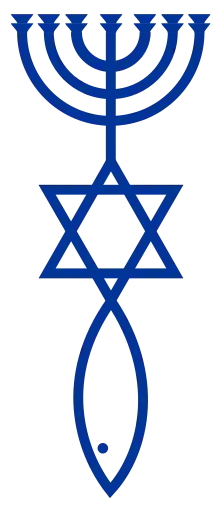Mesiyanik Yahudilik
Mesiyanik/Mesihçi Yahudilik, Yahudilik ile Hıristiyanlık ve İsa'nın Yahudi mesih olduğu inancını birleştiren modern bir senkretik[1] dinî hareket.[2][3][4][5] 1960'larda ve 1970'lerde ortaya çıkmıştır.[6]

Birçok Mesihçi Yahudi İsa'nın[lower-alpha 1] Yahudi Mesihi olduğuna ve Teslis'te yer alan "Tanrı'nın Oğlu" olmasına inanarak Tanah'ı ve Yeni Ahit'i kutsal sayar.[3] Mesih Museviliğinde kurtuluş ancak İsa'nın kurtarıcı olarak kabul edilmesiyle elde edilir ve takip edilen Yahudi yasaları veya gelenekleri kurtuluşa katkıda bulunmaz. İsa'nın mesihliğine olan inanç, kurtarma gücü ve tanrısallığı Yahudi yetkililer tarafından Hıristiyanlık ve Yahudilik arasındaki belirleyici ayrım olarak kabul edilmektedir. Protestan gruplar genellikle Mesih Yahudiliğini bir Protestanlık biçimi olarak kabul ederler.
Mesih Yahudiliğinin birçok takipçisi etnik olarak Yahudidir[1] ve hareketin Yahudiliğin bir mezhebi olduğunu savunurlar. Birçok takipçi, kendileri tanımlamak için dönme yerine İbranice maaminim (inananlar) kelimesini kullanır, ayrıca takipçiler kendilerini notzrim (Hıristiyanlar) olarak değil, yehudim (Yahudiler) olarak görmektedir. Yahudi örgütleri ve İsrail Yüksek Mahkemesi, Geri Dönüş Yasası ile ilgili davalarda bu iddiayı reddetmiş ve bunun yerine Mesih Yahudiliğini bir Hristiyanlık biçimi olarak kabul etmiştir.
2003'te Amerika Birleşik Devletleri'nde 150 olan Mesihçi ibadethanesi sayısı, 2007'de artış yaşayarak 438'e yükselmiştir. 100'ü İsrail'de olmak üzere dünya çapında yer alan cemaatler genellikle daha büyük Mesihçi Yahudi örgütlerine veya ittifaklarına bağlıdır.[7] 2012 itibarıyla ABD'de 175.000 ile 250.000, İsrail'de 10.000 ile 20.000 ve dünya çapında toplam 350.000 Mesiyanik Yahudi'nin yaşadığı tahmin edilmektedir.
Notlar
- Mesihçi Yahudiler, İsa'yı tanımlamak için sadece İbranice kökenli Yeşua ismini kullanırlar. İsa'nın mesihliğini belirten Yunanca kökenli christos sözcüğü yerine yine İbranice "HaMesiah" sözcüğü kullanılır.
Kaynakça
- Özel
- Kessler 2005.
- Ariel 2000.
- Cohn-Sherbok 2000.
- Ariel 2006, p. 191: "In the late 1960s and 1970s, both Jews and Christians in the United States were surprised to see the rise of a vigorous movement of Jewish Christians or Christian Jews. For many observers, such a combination seemed like an oxymoron, because they saw the two faiths as completely separate from each other. While Christianity started in the first century of the Common Era as a Jewish group, it quickly separated from Judaism and claimed to replace it; ever since the relationship between the two traditions has often been strained. But in the twentieth century, groups of young Jews claimed that they had overcome the historical differences between the two religions and amalgamated Jewish traditions and customs with the Christian faith. Attempting to overcome the historical difference between the two religious traditions, these Jewish converts to Christianity define themselves as Messianic Jews, thus pointing to the movements ideology of returning to the roots of the Christian faith."
- Melton 2005, p. 373: "Messianic Judaism is a Protestant movement that emerged in the last half of the 20th century among believers who were ethnically Jewish but had adopted an Evangelical Christian faith ..." By the 1960s, a new effort to create a culturally Jewish Protestant Christianity emerged among individuals who began to call themselves Messianic Jews.
- Cohn-Sherbok 2010, s. 100: "In the 1970s a number of American Jewish converts to Christianity, known as Hebrew Christians, were committed to a church-based conception of Hebrew Christianity. Yet, at the same time, there emerged a growing segment of the Hebrew Christian community that sought a more Jewish lifestyle. Eventually, a division emerged between those who wished to identify as Jews and those who sought to pursue Hebrew Christian goals.…In time, the name of the movement was changed to Messianic Judaism.
- Schoeman 2003.
- Genel
- Ariel, Yaakov S. (2000). Evangelizing the chosen people: missions to the Jews in America, 1880–2000. Chapel Hill: University of North Carolina Press. ISBN 978-0-8078-4880-7. OCLC 43708450.
- Kessler, Edward (2005). "Messianic Jews". In Kessler, Edward; Wenborn, Neil (eds.). A Dictionary Of Jewish-Christian Relations. Cambridge, England: Cambridge University Press. ISBN 978-0-521-82692-1. LCCN 2005012923.
- Cohn-Sherbok, Dan (2000). Messianic Judaism: A Critical Anthology. London; New York: Continuum International Publishing Group. ISBN 978-0-8264-5458-4. LCCN 99050300.
- Cohn-Sherbok, Dan (2010). Judaism Today. London; New York: Continuum International Publishing Group. ISBN 978-0-8264-2231-6. LCCN 2009045430.
- Schoeman, Roy H. (2003). Salvation is from the Jews: the role of Judaism in salvation history from Abraham to the Second Coming. San Francisco: Ignatius Press. ISBN 9780898709759. LCCN 2003105176.
